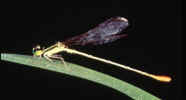Common Names: Bog dancer, Damselfly, Damsel, Narrow wing
Scientific name:
Agriocnemis femina femina, A. pygmaea
Odonata:Calyopterygidae
Type
Generalist predators
Hosts
Leafhoppers, moths and butterflies, plant hoppers (Shepard; Barrion; Litsinger, 1987: p. 127)
Description
Eggs are laid in emerging plants, in floating vegetation, or directly in the water. The hatched eggs do not go through the larval and pupal stages.
A naiad (nymph of damselfly) lives in water, has an elongated body,
long legs, and three leaf-like appendages or gills on its tail. These appendages are used for oxygen transport. A naiad molts several times before emerging. At this stage, naiads are very good predators. They prey aquatic insects and other arthropods within their reach. They grab their prey with their modified lower jaw. At the last stage, a naiad swims out of the water and clings to a plant to dry its skin. After a few minutes of drying in the sun, its outer skin splits open at the head and the adult damselfly strains to pull itself out of its old skin. The new legs harden to hold onto the plant. Its wings slowly expand and are pumped open by fluid from its abdomen.
An adult damselfly has a long thin body which is green, blue, red, yellow, black, or brown and is often brightly colored. It has an oblong head with bulging eyes and very short antennae. When resting, it holds its four large membranous wings of nearly equal size vertically rather than horizontally. It is a delicate and weak-flying
insect. Its wings are usually clear except for a spot at the end of the wing called a stigma. The male sex organ is located at the front part of the abdomen. Damselflies commonly fly in pairs during mating. Damselfly adults use their hind legs, which are covered with hairs to capture prey as they fly. They hold the prey in their legs and devour it by chewing. Adults are usually found flying near plants, usually in irrigated rice fields during the daytime throughout the year. The damselfly's mating pattern is unusual. The male deposits sperm by bending the abdomen forward and then clasping the female behind the head with its claspers on the tip of his abdomen. The female then loops her abdomen forward and picks up the sperm from the male. The mating pairs are seen flying and clinging in tandem. Most species have one generation per year depending on the species, although they complete their life cycle from 1-2 years.
Conservation
Damselflies live in rice paddies, streams, and ponds
with good water quality at low and middle elevations. They are often used as an indicator of whether the water is clean or not (IRRI, 2001). To conserve them, avoid using indiscriminate use of pesticides.
External links
References
- CABI. (2000): Crop protection compendium. Global module, 2nd edition. CABI Publishing, Wallingford, UK.
- IRRI & Queensland University. (2001): Rice IPM. An interactive information and identification system for integrated pest management in rice. University of Queensland and IRRI.
- Shepard, B.; Barrion, A.; Litsinger, J. (1987): Helpful insects, spiders, and pathogens. International Rice Research Institute. Manila, Philippines.
- Yepsen, R. Editor. (1984): The encyclopedia of natural insect and disease control. Rodale Press, Emmaus, PA.

